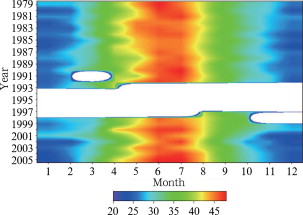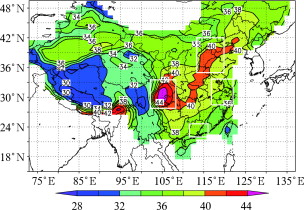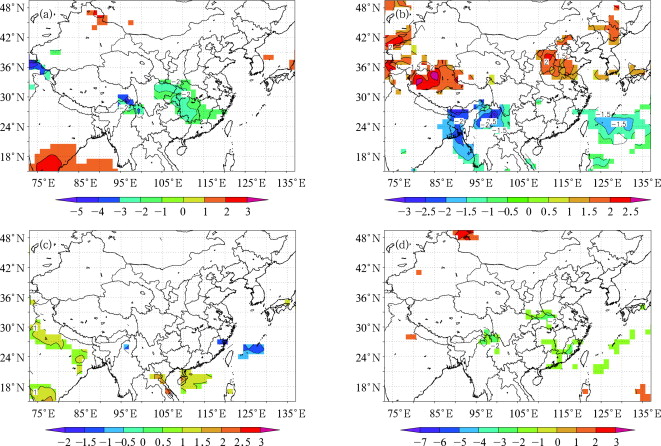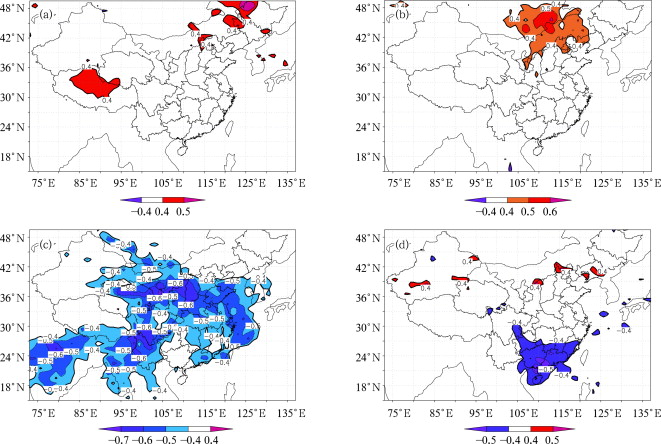Abstract
Long-term trends of yearly and seasonal averages of tropospheric ozone over the whole country and some important regions of China during 1979–2005 are analyzed, based on tropospheric ozone residue (TOR) data retrieved from satellite measurements. The relationship between the TOR and Southern Oscillation Index (SOI) is studied. The results show that, over the whole country, there is a slight increase of TOR in summer and a decrease in other seasons, while the overall trend for the whole period is insignificant. There are decreasing trends of TOR over the Pearl River Delta and the Sichuan Basin. Significant increasing trends of TOR are found over the North China Plain (NCP) for all seasons except for winter, with a maximum rate of 1.10 DU per decade for summer. There are significant correlations between TOR and SOI for some regions in China but not for the NCP, suggesting that the observed increasing trend of TOR over the NCP may not be linked with changes in atmospheric circulations.
Keywords
China ; tropospheric ozone ; long-term trend ; SOI
1. Introduction
Although tropospheric ozone (O3 ) contributes only about 10% to the total column O3 [ Staehelin et al., 2001 ], its direct radiative forcing is significant. Moreover, tropospheric O3 is a strong oxidant and precursor of OH radical, hence can exert indirect radiative forcing to the atmosphere by changing the lifetimes of some other greenhouse gases. The increase of O3 precursors’ emission since the Industrial Revolution has led to a significant enhancement of tropospheric O3 abundance, increasing a radiative forcing of 0.35 W m−2 [ IPCC, 2007 ]. Tropospheric O3 over Europe and North America has experienced a long increasing period and has shown no general turn around until now though a leveling off has occurred in recent decades over some regions. In the meantime, a rise in tropospheric O3 has occurred gradually over some regions with higher economic growths, including China and other populated and rapidly developing Asian regions. Giving the potential of economic development and related increase in energy consumption in these regions, it is likely that tropospheric O3 will increase further in this century.
As most of China’s territory is located in subtropical and mid-latitudinal zones in the Northern Hemisphere, the meteorological conditions in China are good for atmospheric photochemistry. The favorable photochemical conditions, together with the increasing emission of O3 precursors due to the sustained economic growth [ Zhang et al., 2007 ], may contribute to the long-term change of regional O3 level, which may have impact on China’s climate and atmospheric environment. Although regional distributions of tropospheric O3 over China were obtained in some model studies [ Wang and Li, 1998 ; Luo et al ., 2000 ; Ma et al ., 2002a ; 2002b ; Wang et al., 2005 ], the analysis of the long-term trend of tropospheric O3 requires to rely on satellite measurements and O3 sounding. However, long-term satellite and sounding measurements of tropospheric O3 over most areas of China are not available. The tropospheric ozone residue (TOR), one of the NASA satellite products of O3 , can be used as a surrogate of tropospheric column O3. The TOR data were used to obtain the long-term trend of tropospheric O3 over China’s Yangtze River Delta (YRD) during 1978–2000 and it was found that it increased at 0.82 DU per decade [ Xu et al., 2007 ]. Ding et al. [2008] analyzed the long-term change of tropospheric O3 over Beijing and its surrounding areas using tropospheric O3 data collected by commercial aircrafts and obtained an increase rate of 2% of the daytime O3 concentration per year in the lower troposphere. So far, long-term changes of tropospheric O3 over many regions of China are unclear, making it difficult to assess the contribution of tropospheric O3 to climate change. In this paper, we present trends of tropospheric O3 over different regions of China, based on the TOR data updated through 2005, and study the relationship between the TOR and the Southern Oscillation Index (SOI).
2. Data and method
The TOR data used in this paper are obtained from the data server of NASA Langley Research Center (http://asd-www.larc.nasa.gov/TOR/data.html ). The data with a resolution of 1.00° latitude by 1.25° longitude covering most of the period 1979–2005 are suitable for trends analysis. The TOR data were validated using O3 sounding as they proved to be reliable [ Fishman et al., 2003 ; Wozniak, 2005 ], and were used to obtain the long-term trend of tropospheric O3 over the YRD [ Xu et al., 2007 ]. Details about the TOR data can be found in the literature [ Xu et al ., 2007 ; Fishman et al ., 2003 ; Wozniak, 2005 ]. Since the TOR data are limited to the latitudinal band between 49.5°S and 49.5°N, this paper focuses on the TOR over China area between 15°N and 49.5°N (hereafter “China 15°−49.5°N”).
The monthly SOI, the sea level pressure difference between Tahiti and Darwin, is produced by NOAA Climate Prediction Center. The SOI data and the calculation method are available athttp://www.cpc.ncep.noaa.gov/data/indices/ .
Since this paper focuses on the general trend during 1979–2005, linear trends of tropospheric O3 are analyzed, though oscillations for periods of 25–44 months were found in the tropospheric O3 over different regions of China [ Wang et al., 2007 ]. In addition, uncertainty in our results may come from data gaps of about 5 years.
3. Long-term trends
Figure 1 shows the seasonal and yearly variations of the TOR over China during 1979–2005. The monthly TOR over China varies from 22 DU to 48 DU, with lower values in winter and higher values in summer. In general, like North America and Europe, China belongs to high TOR regions of the Northern Hemisphere.
|
|
|
Figure 1. Seasonal and yearly variations of the national mean TOR over China 15°–49.5°N during 1979–2005 (unit: DU, monthly TOR data are smoothed, and the white gaps indicate no data)
|
Figure 2 shows the climatological distribution of the TOR over China. As can be seen in this figure, tropospheric O3 is very inhomogeneously distributed over China, with the Sichuan Basin (SB) and the Qinghai-Tibetan Plateau (QTP) having the highest (over 44 DU) and lowest (below 34 DU) TOR, respectively. There is a hook-looking band with higher values, covering the SB, central China, the North China Plain (NCP), and a part of Northeast China. This feature is also seen in Li et al. [2007] . The high TOR over the NCP is consistent with the high level of NO2 (an O3 precursor) over the vast area [ Zhang et al., 2007 ]. Although the emissions of O3 precursors in the YRD and Pearl River Delta (PRD) are considerably higher, the climatological TOR over these regions is lower than that over the SB and the NCP. The difference may be caused by smaller areas of high O3 precursor over the YRD and PRD regions on the one hand [ Zhang et al., 2007 ]. On the other hand, both the YRD and PRD are coastal areas and there tropospheric O3 is strongly influenced by cleaner oceanic air masses, particularly in summer, leading to lower TOR values.
|
|
|
Figure 2. Climatological distribution of the TOR over China 15°–49.5°N during 1979–2005 (unit: DU, and the SB, the NCP, the YRD and the PRD are marked with white rectangles)
|
To investigate the long-term trend of tropospheric O3 over China, linear regressions were made on the seasonal average TOR data over different grids. The obtained trends are presented in Figure 3 , which shows no significant trend for most regions of China and for all seasons. However, in spring, there are significant decreasing trends of TOR over the eastern Sichuan, Chongqing, south central China, and southeast part of the QTP, with a maximum decrease rate larger than 2.0 DU per decade. The summer data show significant increasing trends of the TOR over the west part of the QTP, the NCP, and a part of Northeast China, with increase rates higher than 0.5 DU per decade. The winter TOR shows decreasing trends over some smaller areas in central China and South China, while the fall TOR shows no significant trends over China 15°−49.5°N.
|
|
|
Figure 3. Long-term trends of seasonal average TOR over China 15°–49.5°N during 1979–2005: (a) spring, (b) summer, (c) fall, (d) winter (unit: DU per decade, and trends in the shadowed areas are significant at α = 0.05)
|
Table 1 shows the long-term trends of the yearly and seasonal TOR over China 15°−49.5°N and four key regions, i.e., the NCP, the YRD, the PRD, and the SB. The TOR over China 15°−49.5°N demonstrates weak decreasing trends for all seasons except for summer and all the trends are statistically insignificant (α = 0.05). The TOR over the PRD and the SB show generally decreasing trends, and these trends are relatively large and significant for some seasons or the whole year. The TOR over the YRD has nearly no trend in summer and slight decreasing trends in other seasons, which are statistically insignificant.
| Region | Whole year | Winter | Spring | Summer | Fall |
|---|---|---|---|---|---|
| China 15° −49.5°N | −0.12 | −0.28 | −0.44 | + 0.20 | −0.19 |
| NCP | + 0.30 | −0.26 | + 0.09 | + 1.10* | + 0.27 |
| YRD | −0.34 | −0.50 | −0.73 | + 0.02 | −0.18 |
| PRD | −0.64 | −1.47* | −1.43* | −0.10 | −0.28 |
| SB | −0.71* | −0.31 | −1.20* | −0.34 | −0.60 |
- . significance (α = 0.05)
Although the above data show that there is no significant trend of the TOR over most of the regions of China during 1979–2005, the positive trends of the TOR over some regions warrant attention. The most noteworthy is the TOR over the NCP, which shows significant increasing trends in the whole year and in all seasons except for winter. The largest increase occurs in summer, with a rate of 1.10 DU per decade (α = 0.05). Measurements of tropospheric O3 over Beijing and its surrounding areas, a part of the NCP, have been made by some commercial aircrafts participating in the MOZIAC Program (http://mozaic.aero.obsmip.fr/web/ ). An analysis of these measurements shows a yearly increase of 2% in the lower tropospheric O3 during 1995–2005 [ Ding et al., 2008 ], consistent with the trend of the TOR. Since the NCP is one of the population centers in China and has well developed industry and agriculture, the increasing trend of tropospheric O3 over this region may be a result of the increase in the emissions of O3 precursors. However, tropospheric O3 may be significantly influenced by atmospheric oscillations, e.g., Arctic Oscillation and Southern Oscillation [ Creilson et al ., 2005 ; Fishman et al ., 2005 ]. This influence should be addressed.
4. A link to Southern Oscillation
Creilson et al. [2005] and Fishman et al. [2005] showed that tropospheric O3 over the Pacific and surrounding regions is closely related to El Niño-Southern Oscillation (ENSO). To investigate the relationship between tropospheric O3 over China and ENSO, correlation coefficients between the seasonal TOR data and the SOI data were calculated and are displayed in Figure 4 . In spring, the TOR over the middle of the QTP, the north of Northeast China, and a part of North China, is positively correlated to the SOI, with correlation coefficients higher than 0.4 (α = 0.05). A positive correlation also exists between the SOI and the summer TOR over the northern part of North China, extended to Mongolia, with correlation coefficients higher than 0.4 (α = 0.05). In winter, the TOR over South China and parts of Chongqing and Guizhou provinces is negatively correlated to the SOI, with correlation coefficients lower than −0.4 (α = 0.05). The TOR-SOI relationship in fall is most noticeable, because the TOR-SOI correlations are all negative for the Chinese land area except for the middle-west part of the QTP, the Xinjiang Uygur Autonomous Region, Northeast China, the northern part of North China, and parts of South and Southwest China. The negative TOR-SOI correlation coefficients for the zone from Shanxi to Qinghai and for parts of Sichuan and Yunnan provinces are even lower than −0.6 (α = 0.05), suggesting a very close link between the TOR over these regions and the SOI in fall.
|
|
|
Figure 4. Correlation coefficients between the TOR and SOI for (a) spring, (b) summer, (c) fall, and (d) winter (the correlations in the shadowed areas are significant at α = 0.05)
|
Comparing Figure 3 b with Figure 4 b suggests that the positive trends of the summer TOR over the middle-west part of the QTP, the NCP, and a part of Northeast China, cannot be explained by the TORSOI relationship. The increasing trend of the TOR over the NCP and a part of Northeast China may be caused by increasing emissions of O3 precursors in these regions, while the increasing trend of the TOR over the middle-west part of the QTP may probably be caused by pollutions in the surrounding South and Central Asia regions [ Fishman et al., 2003 ]. However, these suppositions remain to be proved.
5. Conclusions
The monthly tropospheric O3 over China 15°−49.5°N varied in the range of 22–48 DU, with lower and higher values occurring in winter and summer, respectively. Like North America and Europe, China belongs to high TOR regions of the Northern Hemisphere. The abundance of tropospheric O3 shows large differences between different regions of China. The highest and lowest levels of tropospheric O3 are found in the SB (over 44 DU) and the QTP (below 34 DU), respectively. There is a hook-looking band with higher values, covering the SB, central China, the NCP, and part of Northeast China.
During 1979–2005, tropospheric O3 over China 15°−49.5°N had a slight increase in summer and a decrease in other seasons. Tropospheric O3 decreased significantly over the PRD and the SB. Significant increasing trends of tropospheric O3 are found over the NCP for all seasons except for winter, with a maximum rate of 1.10 DU per decade for summer. Changes in Southern Oscillation may have positive or negative impact on tropospheric O3 over different regions of China and in different seasons. However, the observed increasing trend of tropospheric O3 over the QTP and the NCP is not linked with changes in atmospheric circulations and probably caused by enhanced emissions of O3 precursors in these regions and their surroundings. In view of the importance and complexity of tropospheric O3 , more attention should be paid to the long-term changes of tropospheric O3 over different regions and the reasons of the changes.
Acknowledgements
The TOR data are from NASA Langley Research Center. We thank Wanyun Xu for her help in data processing. This work has been supported by the Chinese National Science Foundation (40775074) and China Meteorological Administration (GYHY(QX)200706005).
References
- Creilson et al., 2005 J.K. Creilson, J. Fishman, A.E. Wozniak; Arctic Oscillation-induced variability in satellite-derived tropospheric ozone; Geophys. Res. Lett., 32 (2005) http://dx.doi.org/10.1029/2005GL023016 L14822
- Ding et al., 2008 A.J. Ding, T. Wang, V. Thouret, et al.; Tropospheric ozone climatology over Beijing: Analysis of aircraft data from the MOZAIC program; Atmos. Chem. Phys., 8 (2008), pp. 1–13
- Fishman et al., 2003 J. Fishman, A.E. Wozniak, J.K. Creilson; Global distribution of tropospheric ozone from satellite measurements using the empirically corrected tropospheric ozone residual technique: Identification of the regional aspects of air pollution; Atmos. Chem. Phys., 3 (2003), pp. 893–907
- Fishman et al., 2005 J. Fishman, J.K. Creilson, A.E. Wozniak, et al.; The interannual variability of stratospheric and tropospheric ozone determined from satellite measurements; J. Geophys. Res., 110 (2005) http://dx.doi.org/10.1029/2005JD005868 D20306
- IPCC, 2007 IPCC; S. Solomon (Ed.), et al. , Climate Change 2007: The Physical Science Basis. Contribution of Working Group I to the Fourth Assessment Report of the Intergovernmental Panel on Climate Change, Cambridge University Press (2007), p. 996
- Li et al., 2007 Y. Li, C. Zhao, Y. Fang, et al.; Analysis of distribution and seasonal change of tropospheric ozone residual in recent 20 years using satellite data; Journal of Applied Meteorological Science (in Chinese), 18 (2) (2007), pp. 181–186
- Luo et al., 2000 C. Luo, J.C. St, X. Zhou John, et al.; A nonurban ozone air pollution episode over eastern China: Observations and model simulations; J. Geophys. Res., 105 (D2) (2000), pp. 1889–1908
- Ma et al., 2002a J. Ma, H. Liu, D. Hauglustaine; Summertime tropospheric ozone over China simulated with a regional chemical transport model, 1, model description and evaluation; J. Geophys. Res., 107 (D22) (2002), p. 4660 http://dx.doi.org/10.1029/2001JD001354
- Ma et al., 2002b J. Ma, X. Zhou, D. Hauglustaine; Summertime tropospheric ozone over China simulated with a regional chemical transport model, 2, source contributions and budget; J. Geophys. Res., 107 (D22) (2002), p. 4612 http://dx.doi.org/10.1029/2001JD001355
- Staehelin et al., 2001 J. Staehelin, N.R.P. Harris, C. Appenzeller, et al.; Ozone trends: A review; Rev. Geophys., 39 (2) (2001), pp. 231–290
- Wang and Li, 1998 X. Wang, X. Li; A numerical study of the variations and distributions of tropospheric ozone and its precursors over China; Acta Meteorologica Sinica (in Chinese), 56 (3) (1998), pp. 333–348
- Wang et al., 2007 Y. Wang, Y. Liu, X. Liu; Spatio-temporal characteristics of satellite observed tropospheric ozone over China; , Proceedings of the 24th Annual Meeting of Chinese Meteorological Society (in Chinese) (2007) Guangzhou November 17–18
- Wang et al., 2005 W. Wang, J. Wu, H. Liu, et al.; Researches on the influence of pollution emission on tropospheric ozone variation and radiation over China and its adjacent area; Chinese Journal of Atmospheric Sciences (in Chinese), 29 (5) (2005), pp. 734–746
- Wozniak et al., 2005 A.E. Wozniak, J. Fishman, P. Wang, et al.; Distribution of stratospheric column ozone (SCO) determined from satellite observations: Validation of solar backscattered ultraviolet (SBUV) measurements in support of the tropospheric ozone residual (TOR) method; J. Geophys. Res., 110 (2005), p. D20305 http://dx.doi.org/10.1029/2005JD005842
- Xu et al., 2007 X. Xu, W. Lin, T. Wang, et al.; Long-term trend of tropospheric ozone over the Yangtze Delta Region of China; Adv. Clim. Change Res., 3 (2007), pp. S60–S65
- Zhang et al., 2007 X. Zhang, P. Zhang, Y. Zhang, et al.; The trend, seasonal cycle, and sources of tropospheric NO2 over China during 1996-2006 based on satellite measurement ; Science in China Series D, 50 (12) (2007), pp. 1877–1884
Document information
Published on 15/05/17
Submitted on 15/05/17
Licence: Other
Share this document
Keywords
claim authorship
Are you one of the authors of this document?




